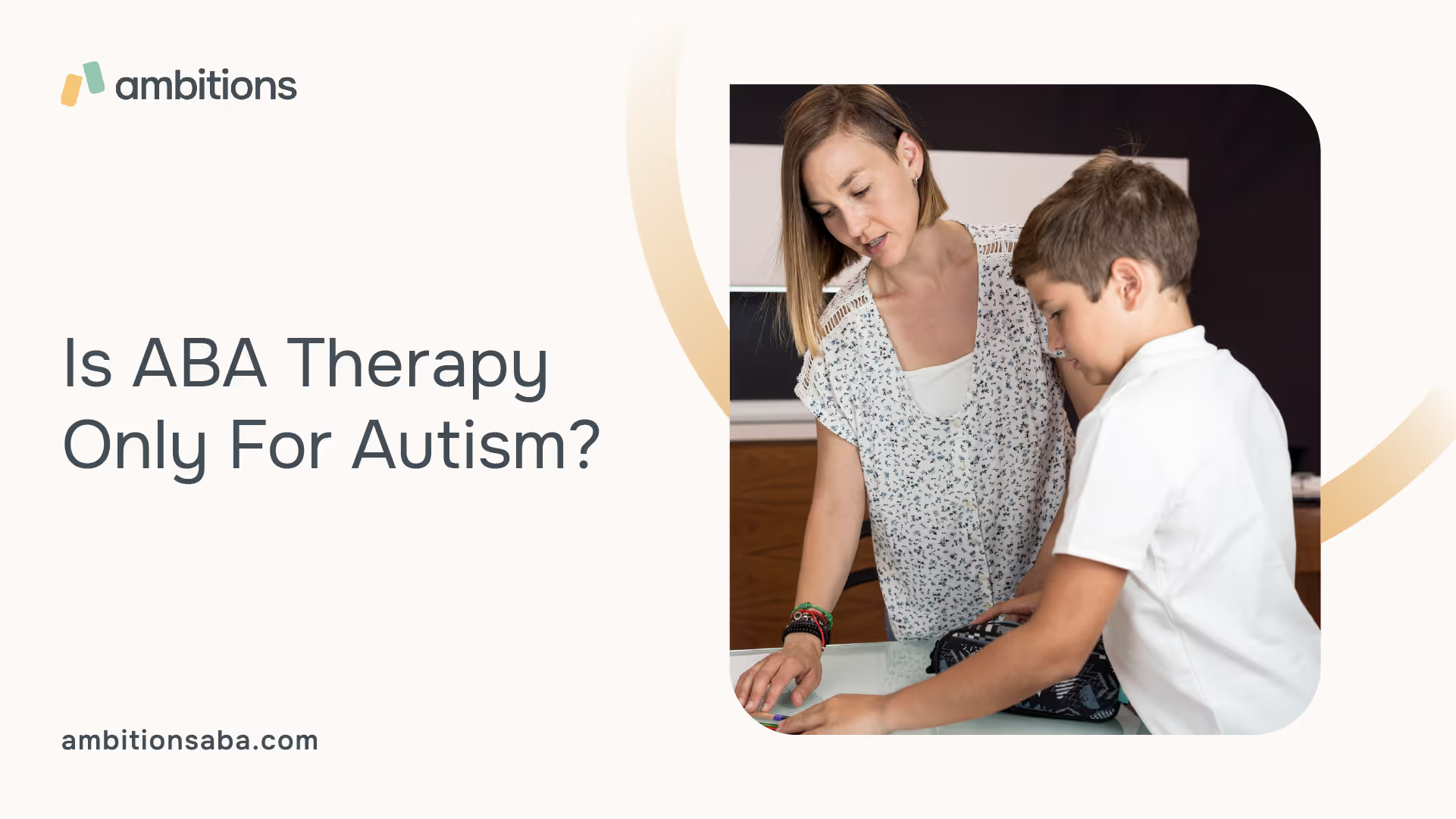A Comprehensive Guide to Applied Behavior Analysis
Understanding ABA Therapy
Applied Behavior Analysis (ABA) therapy, as defined by WebMD, is a specialized intervention designed to help children on the autism spectrum develop social and emotional skills. This therapy approach involves working one-on-one with a practitioner to improve social skills through interventions based on learning theory principles.

Basics of ABA Therapy
The main goal of ABA therapy is to assist individuals with autism in adapting to social scenarios they may find challenging. It utilizes positive reinforcement, where a child receives a reward for completing a task correctly, making them more likely to repeat the behavior. Conversely, negative behaviors are discouraged through consequences, where negative behaviors are met with no response until the child cooperates. This approach helps children on the autism spectrum learn and develop new skills, enabling them to navigate social situations more effectively.
Role of a BCBA
A crucial component of ABA therapy is the involvement of a Board Certified Behavior Analyst (BCBA). A BCBA is a professional who is trained in the principles and techniques of ABA therapy. They play a vital role in developing and implementing individualized treatment plans for children with autism.
The BCBA conducts assessments to identify the specific challenges and areas of improvement for each child. Based on these assessments, they design personalized programs that target the child's unique needs and goals. The BCBA also monitors the child's progress, making adjustments to the treatment plan as necessary to ensure optimal outcomes.
The involvement of a BCBA in ABA therapy provides expertise and guidance to both the child and their family. They collaborate with parents and caregivers, providing training and support to help reinforce the skills learned during therapy sessions. This collaboration helps to extend the progress made in therapy beyond the therapy environment and into the child's daily life.
In summary, ABA therapy is a highly individualized approach that aims to improve social and emotional skills in children with autism. The involvement of a BCBA ensures that the therapy is tailored to the specific needs of each child, maximizing the potential for growth and development.
Effectiveness of ABA Therapy
When considering the effectiveness of ABA (Applied Behavior Analysis) therapy, it is important to look at the research findings and understand the benefits across different age groups.
Research Findings
A meta-analysis of 14 randomized control trials with 555 participants found that interventions based on ABA showed significant effects on socialization, communication, and expressive language in children with autism spectrum disorder (ASD) [2]. Several studies have also established that intensive and long-term therapy using ABA principles improves outcomes for many children with autism. These studies have shown gains in intellectual functioning, language development, daily living skills, and social functioning.
A 2011 review examined 27 studies and found that children who received ABA therapy experienced improvements in cognitive abilities, language, adaptive behavior, and social skills. Additionally, a study of 48 toddlers with autism found that 6 months of ABA therapy starting around 2 years old improved their ability to communicate with others and reduced the severity of their autism symptoms [4].
According to the Surgeon General's autism treatment report, ABA therapy accounts for 45% of therapies that develop long-lasting and observable results for individuals with ASD. These findings highlight the positive impact of ABA therapy on various aspects of development and functioning in individuals with autism.
Benefits Across Ages
ABA therapy is effective for people of all ages, from early childhood through adulthood. A 2007 study indicates that children who receive ABA therapy early on in life make more sustained gains in cognition, academics, adaptive behaviors, social behaviors, and language compared to children in control groups.
For adolescents and adults with autism, ABA therapy continues to be effective in improving skills such as communication, social skills, and adaptive living skills. While therapy may look different across various age groups, the principles of ABA remain the same, helping individuals achieve goals and gain greater independence.
Studies show that participants in intensive, long-term ABA therapy (25 to 40 hours per week for one to three years) have shown gains in various areas, indicating positive outcomes for children who receive applied behavior analysis. This highlights the potential long-term benefits of ABA therapy for individuals of all ages.
The effectiveness of ABA therapy is supported by research and has been shown to provide significant improvements in socialization, communication, language, and various other skills across different age groups. It is a valuable intervention for individuals with autism spectrum disorder, helping them reach their full potential and improve their quality of life.
ABA Techniques and Strategies
When it comes to ABA therapy, various techniques and strategies are employed to support individuals in developing new skills and behaviors. The goal of these techniques is to reinforce positive behaviors while discouraging negative ones.
Positive Reinforcement
Positive reinforcement is a fundamental technique used in ABA therapy to encourage and strengthen desired behaviors. It involves providing rewards or praise when a person exhibits the target behavior. By associating positive outcomes with specific actions, individuals are more likely to repeat those behaviors in the future. Consistency in applying positive reinforcement is crucial to avoid confusion and ensure effective learning [6].
Video Modeling
Video modeling is another technique within ABA therapy that leverages visual learning to teach new skills and behaviors. This approach involves showing individuals videos of others performing the desired actions or behaviors. By watching and imitating these behaviors, individuals with autism can learn and develop new skills. Video modeling can be particularly effective for individuals who are visual learners and may struggle with verbal instructions.
Prompting and Fading
Prompting and fading is a technique used to teach new skills and promote independence. It involves providing prompts or cues to guide individuals through the desired behavior initially. As the individual becomes more proficient, the prompts are gradually reduced to encourage independent execution of the behavior. This technique allows individuals to develop new skills at their own pace while gradually decreasing the need for assistance.
By utilizing these ABA techniques and strategies, individuals with autism can learn and develop new skills, improve their behavior, and enhance their overall quality of life. These techniques can be tailored to meet the specific needs of each individual, ensuring a personalized and effective therapy approach. It is important to note that ABA therapy is not limited to autism and can be beneficial for behavior modification in general.
Individualized ABA Therapy
ABA therapy, or Applied Behavior Analysis therapy, is a highly individualized approach that tailors programs to meet the unique needs and challenges of each person. This personalized approach is a key aspect of ABA therapy and allows for effective intervention and skill development. Let's explore two important components of individualized ABA therapy: tailored programs and therapist involvement.
Tailored Programs
ABA therapy recognizes that each individual has their own set of strengths, weaknesses, preferences, and challenges. Therefore, a qualified Board Certified Behavior Analyst (BCBA) works closely with the individual and their family to develop personalized intervention plans that address specific goals and areas of improvement. These plans are customized to the unique needs, skills, preferences, and family situation of the individual with autism.
Tailored programs in ABA therapy involve setting specific goals based on the individual's struggles. These goals may include improving communication skills, social skills, adaptive living skills, and reducing challenging behaviors. The BCBA assesses the individual's abilities and identifies areas that require improvement. Through ongoing assessment and observation, the program is adjusted and modified to ensure progress towards these goals.
Therapist Involvement
In individualized ABA therapy, the involvement of a qualified therapist is crucial. Licensed professionals, such as Registered Behavior Technicians (RBTs) or Board-Certified Assistant Behavior Analysts (BCaBAs), deliver the intervention plans created by the BCBA. These professionals work closely with the individual, implementing the strategies and techniques outlined in the personalized program.
Therapists play a vital role in the success of ABA therapy. They provide direct support and guidance to the individual, helping them acquire and practice new skills. Therapists also collect data on behavior and progress, allowing for ongoing assessment and adjustment of the intervention plan.
The involvement of therapists extends beyond the therapy sessions. They collaborate with families to ensure consistency in implementing strategies and techniques at home. This collaboration between therapists and families creates a supportive environment for the individual, facilitating generalization of skills across different settings.
By tailoring programs and involving qualified therapists, individualized ABA therapy maximizes its effectiveness in addressing the unique needs of each person. This personalized approach allows for targeted skill development, effective behavior management, and improved overall quality of life. It's important to understand that ABA therapy is not limited to autism but can also be beneficial for individuals with other behavioral disorders or concerns.
ABA Therapy Beyond Autism
While ABA therapy is widely recognized for its effectiveness in treating autism spectrum disorder (ASD), its applications extend beyond this specific population. ABA therapy can benefit individuals dealing with a range of behavioral issues, cognitive disorders, developmental delays, and other conditions affecting cognition and behavior.
Non-Autistic Applications
According to Applied Behavior Analysis Edu, ABA therapy is not exclusive to treating autism. It can be effectively utilized for non-autistic children and individuals facing various challenges. Some of the non-autistic applications of ABA therapy include:
Conditions Treated with ABA
ABA therapy has been found to be effective in treating several conditions beyond autism. Here are some examples:
The versatility of ABA therapy allows it to be tailored to the specific needs of individuals with various conditions. By focusing on behavior modification, skill acquisition, and promoting positive outcomes, ABA therapy offers valuable support beyond the realm of autism.
It is important to consult with a qualified Board Certified Behavior Analyst (BCBA) to determine the suitability of ABA therapy for specific conditions and to develop individualized treatment plans that address the unique needs of each individual.
Misconceptions and Realities
When it comes to ABA therapy, there are a few misconceptions that can lead to misunderstandings about its purpose and scope. Let's address two common misconceptions and shed light on the realities of ABA therapy.
ABA Therapy and Autism
One common misconception is that ABA therapy is exclusively for individuals with autism. While it is true that ABA therapy is often applied to help autistic children and adults cope with harmful or dangerous behaviors, its application extends beyond autism [5]. ABA therapy focuses on identifying unsafe behaviors, understanding their triggers, and teaching safer alternative responses to help individuals communicate their needs more safely and effectively. While autism is one of the primary areas where ABA therapy is utilized, it can be beneficial for individuals with other behavioral disorders as well.
ABA Therapy vs. Animal Training
Another misconception arises from a comparison sometimes drawn between ABA therapy in children and animal training. This comparison can lead to negative perceptions by certain individuals who advocate against using reward and consequence systems for social behaviors. It's important to note that ABA therapy is not about changing children to fit socially, but rather about helping them adapt to social scenarios they may not understand. The goal of ABA therapy is to improve social and emotional skills through interventions based on learning theory principles. Positive reinforcement is used, where a child receives a reward for completing a task correctly, making them more likely to repeat the behavior. Conversely, negative behaviors are discouraged through consequences, where negative behaviors are met with no response until the child cooperates.
By understanding these misconceptions and the realities of ABA therapy, parents and caregivers can make informed decisions about its potential benefits for their children. ABA therapy is a personalized approach, setting specific goals based on the individual's struggles [1]. It has a broad application and can be helpful for concerns other than autism, making it applicable not only to children but also to adults with autism and other behavioral disorders as well.
References
[2]:
[3]:
[4]:
[5]:
[6]:
[7]:

